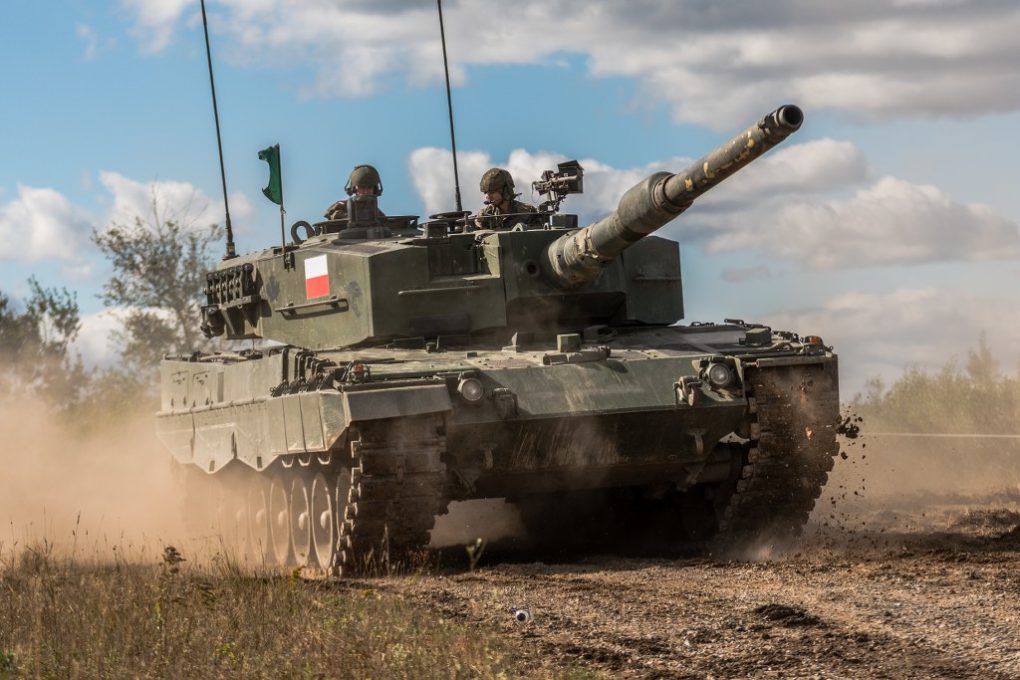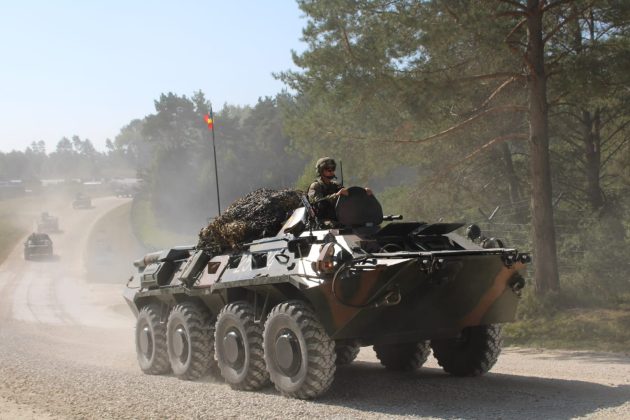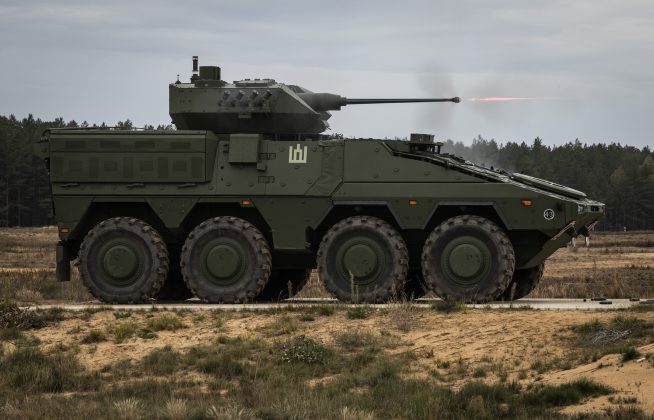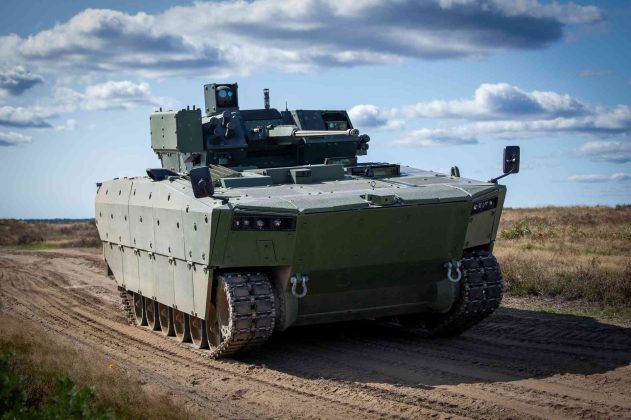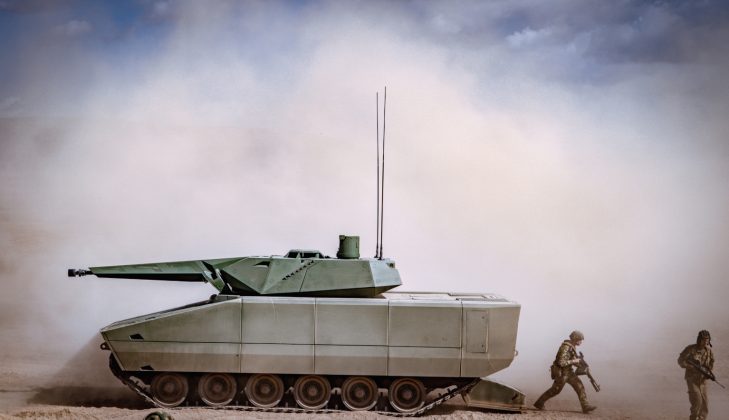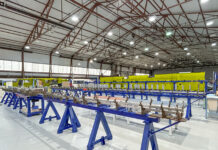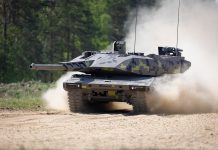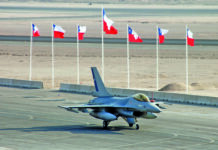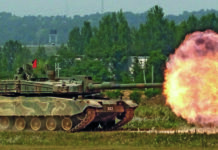Even before the outbreak of the current war in Ukraine, most Eastern European states had plans to acquire new armoured vehicles. Now, in a response to that war, some of them have already intensified their efforts. More purchases should be expected in the near future.
The war in Ukraine came as a shock to many Western European states and their societies, which naively believed in Russia’s peaceful approach and hoped that a major conventional war in Europe was impossible. At the same time, the states belonging to Central/Eastern Europe – from Estonia to Poland and the Czech Republic, to Romania and Bulgaria – have long looked at Russia more soberly. Hence the modernisation programmes initiated in recent years, often also in the field of armoured vehicles. Almost all states from the region decided to boost their land forces according to their own assessments and financial capabilities. This article presents the most important initiatives.
Bulgaria
Bulgaria is among those Eastern European countries, which still has to make binding decisions. Sofia’s arsenal is composed of legacy systems, including the T-72A/M2 tanks (up to 90 in total). In 2020, it was agreed that 44 T-72s would be modernised locally at the facilities of the Terem Khan Krum EOOD, located in Targovishte. Another batch is expected to be upgraded in the future. Tanks are receiving HF/VHF radios with a built-in encryption module and a new fire control system (Elbit’s TIFCS). In order to enhance situational awareness, the 1K13 sight (designed for target observation, search and detection in daylight and at night) is being replaced by the TIFCS-GS (Thermal Imaging Fire Control System-Gunner Sight). Another improvement is Elbit’s E-LAWS laser warning system. Tanks keep their original guns (smoothbore 2A46 125 mm cannons). The first modernised T-72 was presented in late June 2022 during the HEMUS 2022 defence exhibition held in Plovdiv. This is the first ever upgrade of such complexity involving Bulgarian T-72s since the 1980s when they entered service.
When it comes to wheeled vehicles, the situation remains much more uncertain. The government wanted to acquire 150 wheeled (both 8×8 and either 6×6 or 4×4) armoured vehicles for €1.46Bn to replace its Soviet-era wheeled vehicles: BTR-60PB/MDs and the BRDM-2s (also tank-hunters with 9P148 KONKURS ATGMs). The list of bidders included Patria’s AMV-XP and GDELS-MOWAG’s PIRANHA-5, but they both exceeded the estimated budget by 30-50 per cent. The whole project was cancelled, while at the same time the government asked state-owned local company, Terem, to prepare a report on the capabilities of local industry to independently carry out a similar project.
Nevertheless, Bulgaria has been able to procure some new vehicles – the first batch of 45 GUARDIAN XTREME (4x) MRAP vehicles was handed over to the Bulgarian Joint Special Operations Command in January 2022. By the end of the year, Sofia is expected to receive 98 vehicles in 10 variants. Deliveries are carried out by Samel-90, a local company based in Samokov. A design was provided by its industrial partner from the United States – International Armored Group (IAG). The company also promised to invest at least €10.2M in the city of Burgas and to construct facilities which will manufacture the entire range of the company’s products, including its latest armoured infantry vehicle RILA 8×8. The main production hall is expected to be completed in 2024.
Czechia
The Czech Republic (Czechia) is armed with T-72M4Cz tanks, serving in one battalion (only 30 were modernised to this standard, while in the mid-1990s, Prague had a plan to upgrade over 300 T-72s. It is estimated that the Czech Republic has approximately 90 T-72M1s in stock. In 2017, a contract for maintenance and repairs was signed between the Ministry of Defence and VOP CZ. The main goal of this deal was to “restore [the] combat capabilities and operational value” of the T-72M4Cz tanks. It is worth noting that a plan to modernise them was controversial due to a significant disparity between planned and actual costs. This effort was subsequently affected by several delays and numerous obstacles.
At least a dozen Czech tanks have been sent as a donation to Ukraine. In order to fill the gap created, Germany has offered 15 LEOPARD 2A4 tanks (in this context it is worth mentioning that it was previously reported that the Czech Republic would receive LEOPARD 1s). Germany is willing to cover all costs, while the Bundeswehr is ready to train Czech tank crews. Prague has also agreed to buy up to 50 LEOPARD 2A7s. They are expected to be jointly produced by KMW and the Czech defence industry, while the older 2A4 tanks are to be modernised to 2A7 standard in the near future. This procurement and a final withdrawal of outdated T-72s will help Prague achieve its plan of establishing a heavy mechanised brigade.
The Czech Republic has already modernised its fleet of wheeled vehicles – the PANDUR II 8×8 KBVPs (Kolového Bojového Vozidla Pěchoty) has replaced Soviet-era OT-64 SKOTs. The Czech Army plans to modernise these vehicles and increase their number. A desire to procure more PANDUR IIs was officially announced in April 2022. An order is expected next year, while a modernisation is planned between 2024-2027. Possible upgrades include weapon systems, communication and ballistic protection.
At the same time, Prague had serious problems with finding a replacement for tracked BVP-2s (they were serially produced in Czechoslovakia from 1987 to 1989 with a total of 344 units produced) and complement the PANDUR 2 wheeled vehicles currently in service. It was expected that Prague will acquire 210 vehicles in seven variants. Most of them would be standard AIFVs with a turret armed with a 30 mm automatic cannon. Other expected variants include command, reconnaissance, engineer, rescue, medical, and artillery observatory vehicles. Despite the fact that in 2018, three vehicles were shortlisted (CV90, ASCOD and LYNX), in 2021 in was announced that none of them met the requirements. The tender was cancelled when two bidders declined to accept new terms. A happy outcome occurred only in July 2022, when the government gave the Ministry of Defence a green light to start negotiations for the purchase of the CV90s.
Estonia
Estonia has already completed its major armoured vehicle programme: between 2016-2019, the government in Tallinn received 44 CV9035 AIFVs. In addition, Estonia purchased the CV90 Mk1 chassis from Norway. Under an agreement signed in 2021 with two local companies – Scania Eesti AS and AS Ühinenud Depood – roughly 37 Estonian CV90 Mk1s will be rebuilt into nine different combat support roles. Moreover, in the near future, Estonia plans to buy new wheeled armoured vehicles (4×4 and 6×6). Before they are delivered though, Estonian troops will rely on vehicles already in service, such as the XA-180 and XA-188. The former is expected to remain in service until 2038, while the latter until 2048.
Hungary
Hungary is at an advanced stage when it comes to introducing new tanks and major armoured vehicles. Budapest has already procured 44 LEOPARD 2A7+s (2A7HUs) and 12 used 2A4s (2A4HUs) as a replacement for unmodernised T-72M1s (more than 120 in reserve, a small number still in service but they are now being phased out). New tanks have already been deployed to the 11th Tank Battalion in Tata (part of the 25th Infantry Brigade “György Klapka”) mainly for training purposes. Ultimately this tank battalion, the only one in the Magyar Szárazföldi Haderő (Hungarian Ground Forces), is expected to be equipped with the 2A7+s. Deliveries are planned between 2023-2025. The whole package with the 24 PzH2000 howitzers and support vehicles is worth approximately €1 Bn.
Additionally, in March 2022 Budapest ordered from Germany’s Rheinmetall various types of ammunition for several hundred million Euros. Deliveries, planned between 2023-2031, include ammunition for:
- infantry fighting vehicles (30 mm)
- main battle tanks (120 mm)
- artillery (155 mm)
- machine guns (12.7 mm and 7.62 mm)
- 40 mm and 76 mm decoy cartridges for the ROSY and MASKE smoke/obscurant systems
Most of the production will be undertaken by Rheinmetall’s majority-owned ammunition factory in Várpalota.
Hungary also purchased 218 LYNX KF41s for EUR €2Bn, which are intended to replace the Soviet-era BTR-80/80A wheeled vehicles. The first batch of 46 vehicles will be produced in Germany and delivered from 2023, while the rest will be manufactured in Hungary (a joint venture between Germany and Hungary was established in 2020 – with the factory located in Zalaegerszeg). They will be armed with Rheinmetall’s manned LANCE 30 mm turrets and the STRIKESHIELD active protection system (APS) from the same company.
A third important and recently made procurement is the acquisition of the GIDRÁN wheeled (4×4) vehicles, which are based on the Turkish EJDER YALÇIN vehicles by Nurol Makina. The first ten vehicles were officially presented in Tata in late 2021 with the Turkish company set to deliver an additional 40 vehicles. In total, Hungary plans to introduce more than 300 GIDRÁNs, but the majority will be manufactured locally. In March 2022, Nurol Makina opened its facilities in Hungary. Budapest will use GIDRÁNs in various configurations; one of them – with Rheinmetall’s RAGNAROK 120 mm mortar – was tested in April this year.
Latvia
Latvia, similar to Lithuania, does not have any armoured combat vehicles. Its light infantry is now using recently procured Patria wheeled (6×6) vehicles. This procurement was made within a framework agreed in early 2020 between Finland and Latvia in a joint development programme to improve mobility of the ground forces. The first batch of four vehicles was handed over in late 2021. Deliveries for the Latvian Army and the National Guard of more than 200 vehicles for €200M are planned to be completed in 2029. This is the largest modernisation effort in Latvian history and a great opportunity for the local defence industry. Production and maintenance will take place in Latvia as soon as 2023. It is planned to build a new plant in Cēsis this year and six Latvian companies have already been involved in the project.
Poland
The Russian aggression against Ukraine has significantly changed Polish plans; modernisation efforts have been sped up. With at least 240 T-72M1/M1Rs donated to Ukraine, Poland faces an urgent need to fill the resultant gap (it is also highly likely that an unspecified number of the PT-91 TWARDY tanks was also sent to Ukraine). As a result, Poland requested 116 older ABRAMS tanks to replenish those units after their tanks were donated to Ukraine. Deliveries to two battalions are planned for 2023. Poland will cover costs of restoring the tanks to service, their technical reviews and be responsible for logistical support. Most likely it will be the M1A2SA variant, which would be later upgraded to the latest model.
In April this year, Warsaw finally ordered 250 new M1A2 SEPv3 tanks with 26 M88A2 recovery vehicles and 17 M1074 bridge-layers. Deliveries are planned between 2025-2026 with the total contract value, which includes training, logistical support and ammunition, worth approximately €4.66Bn. The first batch of 28 tanks of the SEPv2 variant – which are now being used for training – arrived in Poland in mid-July 2022.
At the same time in late July 2022, Poland confirmed that it would buy K2 BLACK PANTHER tanks from South Korea, which have been offered to the Polish WILK programme (future Polish MBT). South Korea will deliver 180 K2s with deliveries starting this year. During the second phase, Poland will introduce additional K2PLs, likely to be more than 800 vehicles. Production in Poland is expected to be launched in 2026. Poland currently has 13 tank battalions, but soon the Polish Army is expected to grow by one additional battalion (4 x LEOPARD 2A5/2PL, 4 x M1A2 SEPv3, 2 x M1A1SA, 3 x K2), but ultimately Poland wants to rely on two types of tanks only: the ABRAMS and K2, while the LEOPARDs would be phased out.
South Korea will also become a supplier of some tracked vehicles, but the negotiations are still ongoing. It was revealed that Poland prefers to acquire “perspective” rather than “interim” solutions – thus it might mean that Warsaw will receive the AS-21 REDBACK AIFV instead of the older K-21. However, there are voices claiming that the purchase of South Korean vehicles will seriously threaten a domestic project, known as the BORSUK. This vehicle will be armed with the ZSSW-30 remotely-controlled turret fitted with a 30 mm BUSHMASTER II Mk 44S cannon and SPIKE-LR ATGM launcher. In late April 2022, it was agreed that four additional BORSUK prototypes would be delivered by the producer (HSW) to the Polish Army. Preliminary trials of the first prototype have already been completed. It is expected that roughly 588 BORSUKs will be procured by 2035 as a replacement for the Soviet-era BMP-1s. According to the producer, up to 100 vehicles could be delivered annually.
Romania
Romanian armoured capabilities also need a major rejuvenation. As a result of the Russian aggression against Ukraine and the deteriorating security environment in the region, the Ministry of National Defence announced that “fast and efficient solutions” have to be found in order to speed up the process of technical modernisation. The ground forces have been included in those plans, but in reality, only few details have been revealed so far.
This year, a contract to start local production of the PIRANHA 5 8×8 wheeled (8×8) vehicles will be signed. Under a 2018 deal, Romania ordered 227 vehicles in six variants for €895M. In March 2022, it was agreed that a local branch (GDELS-Romania) will establish an industrial consortium with locally-based UMB (Uzina Mecanica Bucuresti), which is owned by Romania’s leading defence group Romarm. It will be responsible for maintaining and assembling the PIRANHA-5s at its Bucharest plant. This year, it was announced that UMB might be purchased by General Dynamics.
It is expected that the MLI-84 tracked AIFVs (based on the BMP-1), particularly those in a basic configuration, will be replaced. This programme has already been approved and will be initiated between 2022-2025. Romania also plans to phase out old vehicles: TAB B33, TAB-77 or TABC-79. The future of Romania’s tank fleet remains unknown, however.
Bucharest has the TR-85/M1 (the latter variant is partially compatible with NATO standards), TR-580 and even some T-55s tanks (in reserve). Some decisions in this regard are expected in the near future. Already in 2018, it was rumoured that Romania was willing to acquire up to 60 new tanks, most likely the LEOPARD 2, which would then be upgraded to the 2A7+ configuration.
Slovakia
Slovakia has been looking for up to 32 new tanks as a replacement for the T-72M1s (22 tanks are deployed in the 2nd Mechanised Brigade’s tank battalion in Trebišov). No decisions have been taken yet, but Bratislava has hinted that it was ready to hand over its T-72s to Ukraine in exchange for LEOPARD 2 tanks in a deal similar to the one between Berlin and Prague. It was reported that Germany was willing to supply Slovakia with only 15 tanks, an idea which was rejected by Bratislava, which needs at least 30 tanks to restore its tank battalion.
A major modernisation initiative is the planned replacement for the BPV-1/2/2Ms tracked AIFVs; a procurement procedure was launched in late 2021. Bratislava is expected to receive 152 vehicles, including:
- 110 in an AIFV configuration
- 15 command vehicles
- nine reconnaissance vehicles
- three vehicles for sniper groups (anti-material rifles)
- nine vehicles for grenade launcher groups
- three recovery vehicles three repair vehicles
First deliveries are planned between 2023-2024. During the second phase, with deliveries between 2027-2030, Slovakia wants to acquire 71 vehicles:
- five combat vehicles
- ten recovery vehicles
- nine repair vehicles
- nine engineer demining vehicles
- nine engineer minelaying vehicles
- nine engineer support vehicles
- 20 units of 120 mm self-propelled mortars
Four products were under consideration: BORSUK (PGZ from Poland), CV90 Mk 4 (FMV + BAE Systems), ASCOD 2 (GDELS) and LYNX KF 41 (Rheinmetall). Finally, in late June this year, Bratislava selected 152 CV9035s, which will be armed with a 35 mm gun. The total deal, including infrastructure costs, is worth roughly €1.69Bn.
At the same time, Slovakia has been refurbishing its fleet of wheeled vehicles, known as BOV (Bojové Obrnené Vozidlo). In order to integrate its military much closer with NATO allies, Bratislava selected – for the second time – Patria’s AMV (8×8) as its new wheeled AIFV. Those vehicles will give Slovakia new capabilities. The contract is worth €447M. A total of 76 vehicles in three variants are planned to be procured during the first phase (2023-2025). Some AMVs will be armed with the TURRA-30 turret from the Slovakian company EVPÚ with a 30 mm cannon and ATGMs. The Patria 8×8 AMVXPs will see service in the Heavy Mechanised Brigade, which is being raised under Slovakia’s Allied commitments.
Lithuania
Among all Central/Eastern European states, Lithuania is one of the most successful when it comes to modernising its armoured fleet. The Lithuanian Army does not have any tanks and relies on the VILKAS (BOXER) wheeled (8x) vehicles. The first deal worth €385M – then for 88 vehicles – was signed in 2016. This was the largest procurement contract in Lithuanian history. In April 2022, Lithuania announced its plan to procure more than 120 additional vehicles. Deliveries would take place between 2023-2024. The Lithuanian variant, which is already in use, is armed with the Rafael SAMSON Mk II RCWS, Orbital ATK MK44S 30 mm gun and Rafael SPIKE-LR ATGMs. Vehicles from the new batch will have some modifications compared to the initial variant, but details have not been revealed – it was only hinted that those changes are a result of a lesson learnt from the Russian-Ukrainian War.
These procurements might help Lithuania speed up the process of retiring its tracked M113s; at least 20 were recently handed over to Ukraine. The rest will continue to be used and for now, there are no specific decisions or timing regarding either a modernisation or retirement of this platform in the near future. Moreover, Lithuania also purchased 200 joint light tactical vehicles (JLTV) for €142M (deliveries are planned between 2020-2024). The first batch of 50 vehicles was handed over to the Geležinis Vilkas Brigade in Rukla in January 2021.
Robert Czulda


